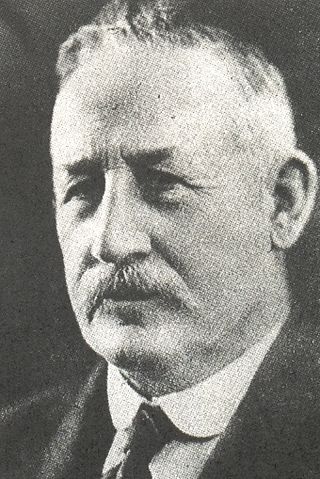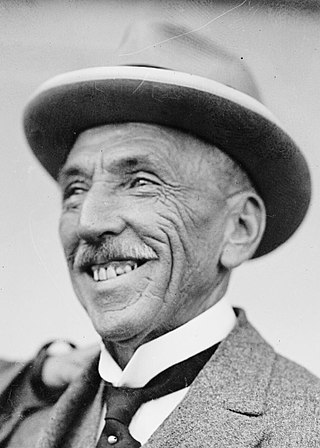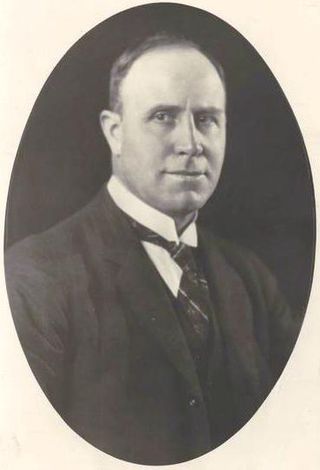
Francis Gwynne Tudor was an Australian politician who served as the leader of the Australian Labor Party from 1916 until his death. He had previously been a government minister under Andrew Fisher and Billy Hughes.

William Alexander Watt was an Australian politician. He served two terms as Premier of Victoria before entering federal politics in 1914. He then served as a minister in the government of Billy Hughes from 1917 to 1920, including as acting prime minister during World War I, and finally as Speaker of the House of Representatives from 1923 to 1926.

John William Leckie was an Australian politician. He served as a Senator for Victoria from 1935 to 1947, having previously been a member of the House of Representatives from 1917 to 1919 and the Victorian Legislative Assembly from 1913 to 1917.

George Michael "Mick" Prendergast was an Australian politician who served as the 28th Premier of Victoria. He was born to Irish emigrant parents in Adelaide, but he grew up in Stawell, Victoria. He was apprenticed as a printer, and worked as a compositor in Ballarat, Sydney and Narrandera before settling in Melbourne in 1887. A member of the Typographical Association, he represented that union at the Melbourne Trades Hall, of which he was President in 1893.

John Allan was an Australian politician who served as the 29th Premier of Victoria. He was born near Lancefield, where his father was a farmer of Scottish origin, and educated at state schools. He took up wheat and dairy farming at Wyuna and was director of a butter factory at Kyabram. In 1892 he married Annie Stewart, with whom he had six children.

The 1919 Australian federal election was held on 13 December 1919 to elect members to the Parliament of Australia. All 75 seats in the House of Representatives and 19 of the 36 seats in the Senate were up for election. The incumbent Nationalist Party government won re-election, with Prime Minister Billy Hughes continuing in office.
The 1918 Swan by-election was a by-election for the Division of Swan in the Australian House of Representatives, following the death of the sitting member Sir John Forrest. Held on 26 October 1918, the by-election led to the election of the youngest person to be elected until 2010 to the Parliament of Australia, Edwin Corboy. It saw the conservative vote split between the Country Party and the Nationalist Party, which directly prompted the introduction of preferential voting in Australia.
The Victorian Farmers' Union (VFU) was an association of farmers and primary producers formed in 1914 in the Australian state of Victoria. Although initially formed as an "absolutely non-political" entity, the VFU became a political party in 1916, and nominated candidates for the 1917 state election and subsequent elections. In later years it used the names Victorian Country Party, then United Country Party and is now the National Party of Australia – Victoria. At the 1917 election, because the support for the VFU was concentrated in rural seats, it won four of the 11 seats in the Victorian Legislative Assembly it contested, gaining about 6% of the vote state-wide. In 1918 it also won its first seat in the federal parliament, after preferential voting was introduced. At the 1920 state election the VFU vote increased to 8% and the number of seats to 13, giving the VFU the balance of power in the state Legislative Assembly.
This article provides information on candidates who stood for the 1919 Australian federal election. The election was held on 13 December 1919.
This is a list of members of the 20th Legislative Assembly of Queensland from 1915 to 1918, as elected at the 1915 state election held on 22 May 1915.
Members of the New South Wales Legislative Assembly who served in the 24th parliament of New South Wales held their seats from 1917 to 1920. They were elected at the 1917 state election on 24 March 1917. Speaker was John Cohen until 19 August 1919 when he was succeeded by Daniel Levy.
A by-election was held for the Australian House of Representatives seat of Echuca on 20 September 1919. This was triggered by the death of Nationalist MP Albert Palmer.
A by-election was held for the Australian House of Representatives seat of Corangamite on 14 December 1918. This was triggered by the death of Nationalist MP Chester Manifold.
A by-election was held for the Australian House of Representatives seat of Flinders on 11 May 1918. This was triggered by the resignation of Nationalist MP Sir William Irvine to become Chief Justice of the Supreme Court of Victoria.
A by-election was held for the Australian House of Representatives seat of Grampians on 27 October 1917. This was triggered by the death of Nationalist MP and former Speaker Carty Salmon.

The 1920 Victorian state election was held in the Australian state of Victoria on Thursday 21 October 1920 to elect the 65 members of the state's Legislative Assembly.

The 1917 Victorian state election was held in the Australian state of Victoria on Thursday 15 November 1917 for the state's Legislative Assembly. 51 of the 65 Legislative Assembly seats were contested.
The Victorian Labor Party, officially known as the Australian Labor Party and commonly referred to simply as Victorian Labor, is the Victorian state branch of the Australian Labor Party (ALP). The branch is currently the ruling party in the state of Victoria and is led by Jacinta Allan, who has served concurrently as premier of Victoria since 2023.

John Joseph Carlisle was an Australian politician.
The People's Party was a political organisation in the Australian state of Victoria. It was established in 1910 by farmers opposed to the Australian Labor Party (ALP). It co-ordinated political campaigns with other anti-Labor organisations, supporting the parliamentary Liberals and later the Nationalists after 1917. It merged into the National Federation in 1917, after an earlier abortive merger with the Commonwealth Liberal Party.
This page is based on this
Wikipedia article Text is available under the
CC BY-SA 4.0 license; additional terms may apply.
Images, videos and audio are available under their respective licenses.










